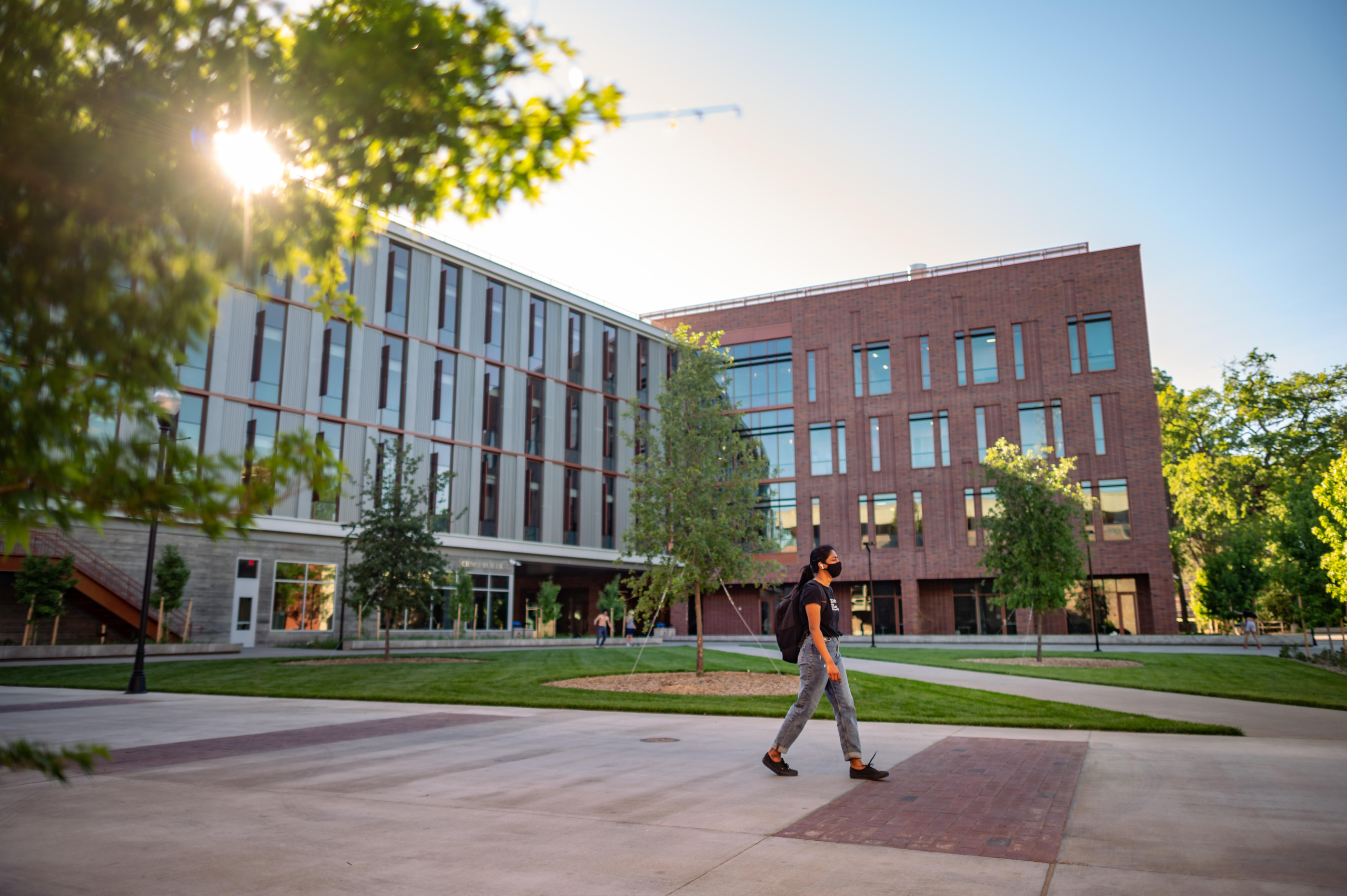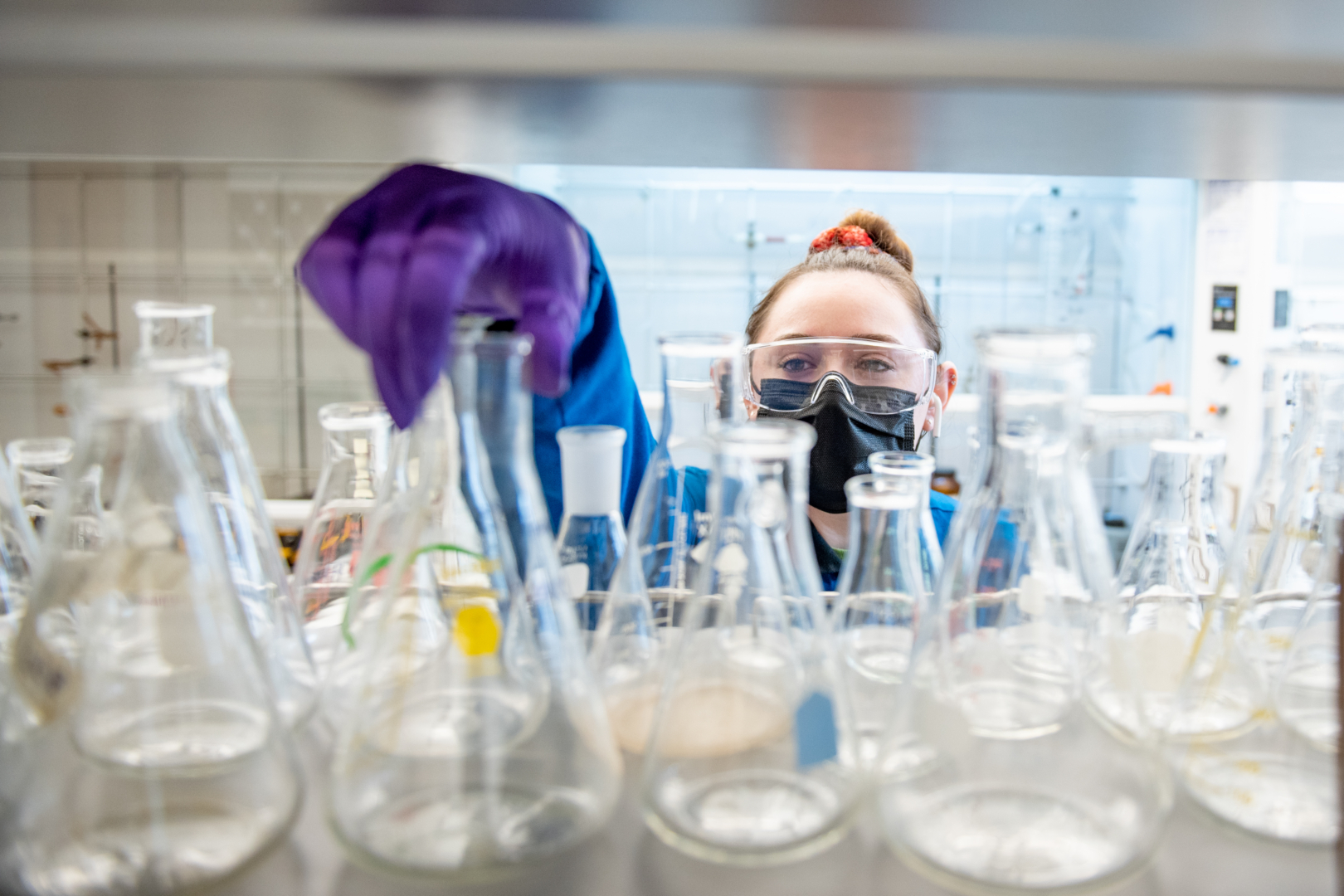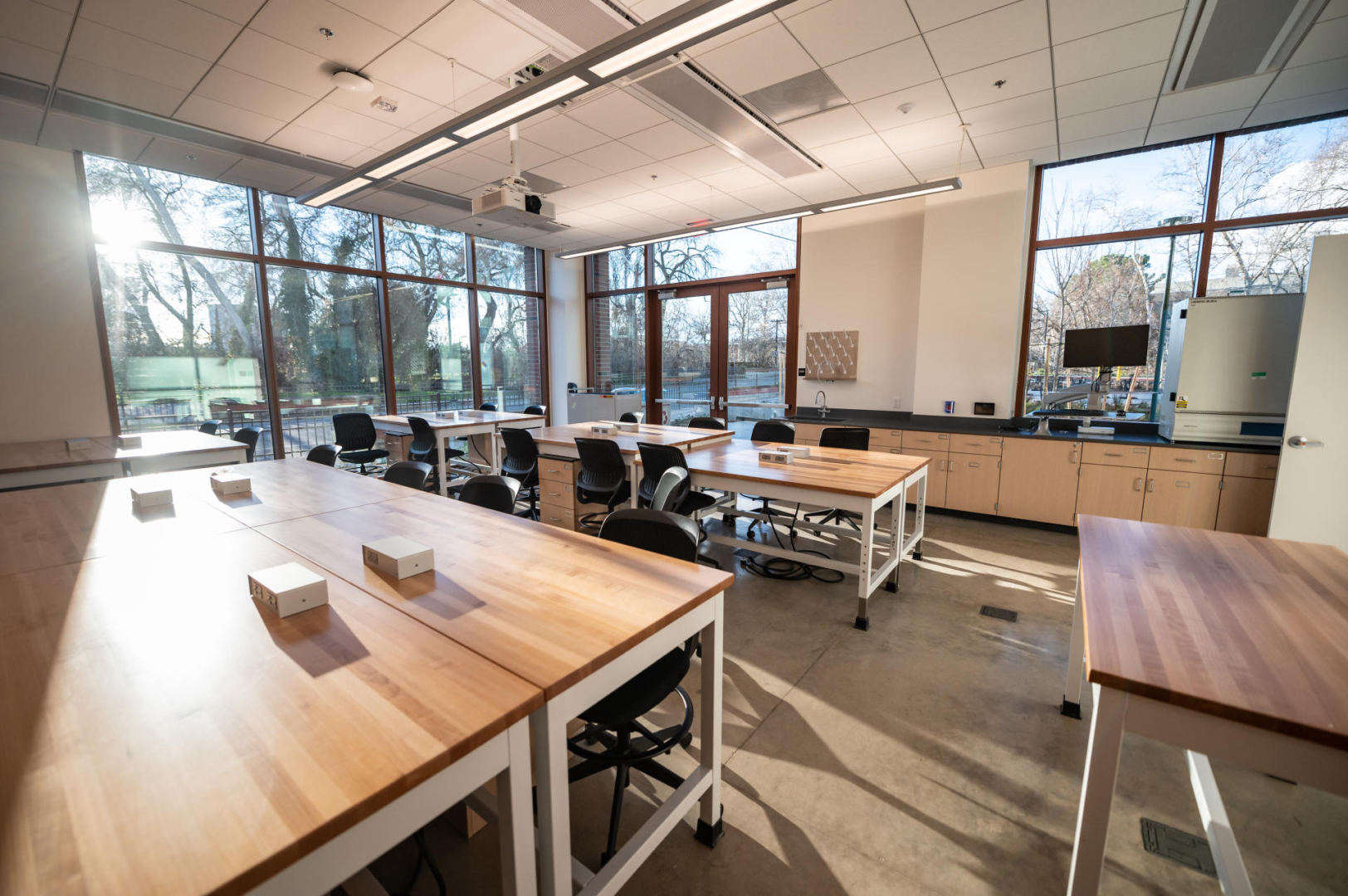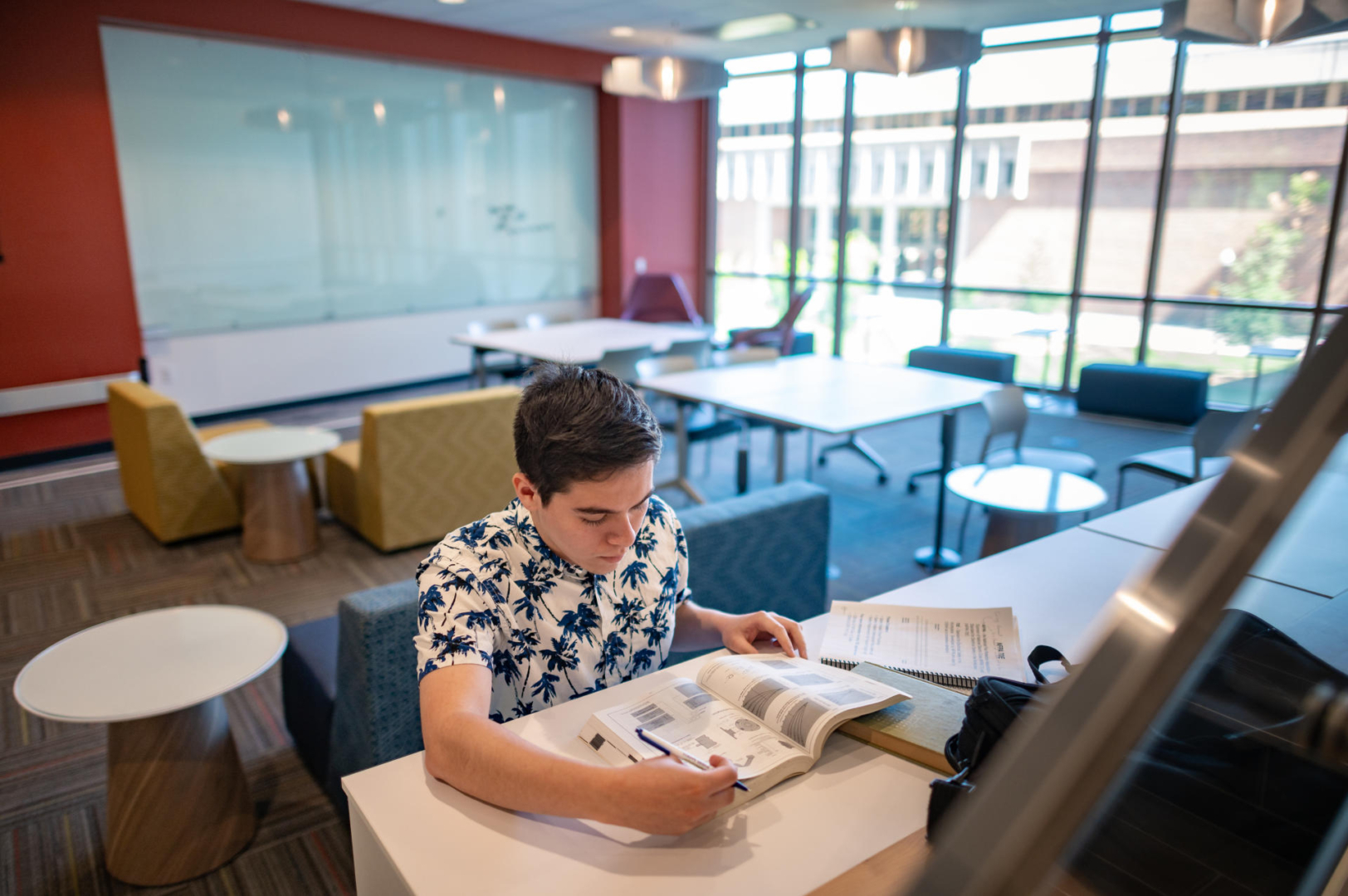Science Takes Center Stage

Pratiksha Kapse walks past the Science Building on Wednesday, April 28, 2021 in Chico, Calif. (Jason Halley/University Photographer/CSU, Chico)
It started with an audacious vision.
What if the sciences could go on display? What if they could be integrated into the core of the physical campus? What if they could transcend disciplines and forge partnerships across campus?
This spring, that dream became reality when the new Science Building opened to students, faculty, and staff. It is not only the most state-of-the-art facility at Chico State, but it is one of the most visionary buildings within the 23-campus California State University system.
“This new building was designed from day one to be a place that draws students to the sciences. Students should feel like science is something they should be doing, and the building should reinforce the feeling that they belong here, and can stick around and continue learning after class,” said College of Natural Sciences Dean David Hassenzahl.
“Traditional science buildings are concrete, and you feel like leaving as soon as you’re done with class—this is an open, inviting building to make people understand that they belong, that science is something they can and want to do.”
The $101 million, 110,200-square-foot facility will advance the University’s role as a leader in the North State and across higher education. It features spaces for chemistry, physics, geological and environmental sciences, and science education, as well as active-learning classrooms, undergraduate and graduate research spaces, designated student club rooms, dozens of faculty offices, and administrative and support areas.
Its innovative spaces and opportunities are not limited to science majors alone. Students in education, engineering, agriculture, and other majors will take classes within its walls, and many general education science classes will call the facility home, giving students across disciplines the opportunity to experience the power and potential of science to transform lives.

The Science Building offers undergraduate students research opportunities not even available to graduate students at most institutions. In its labs during the past few weeks, one student prepared eco-friendly solvents from biodiesel waste just steps away from a peer working on synthesis of degradation products for a new herbicide. Meanwhile, across the hall, other students were working on developing new sustainable electronic materials including light-emitting diodes and photovoltaics.
“Here will be the birthplace of many students’ success and where they will realize their dreams and potential,” said physics professor Hyewon Pechkis.
This fall—three years after breaking ground—the building will open fully with more than 523 in-person class sessions serving thousands of students. But some, like chemistry and biochemistry major Sivan Perets, are thrilled they won’t have to wait that long. She’s already working on the diodes project with Professor Nadia Korovina and will spend the summer working in her lab making and analyzing thermally activated delayed fluorescent molecules.
No doubt, Perets said, this building is going to shape not only her time at Chico State but her dreams of going on to earn a PhD.
“I have been looking forward to it since my freshman orientation, when our advisor pointed at the empty pavement and told us that we would be finishing our undergraduate careers as some of the first students to ever work in the building,” said Perets, now in her third year. “I love that it is so open and that you can see so much of the campus from inside. It is much more exciting to come to the lab each day knowing we will be spending our hours in such a nice, new space.”

GROUNDBREAKING LABS
The building includes a climate-controlled laboratory space and low-noise-level research environment built with ultracold atom experiments in mind. The ultracold laboratory—one of many innovative research opportunities in the new complex—features ample workspace for a magneto-optical trap, lasers, and vacuum technology, as well as prototyping, and complements other open spaces where students can collaborate to nurture creativity in research. Faculty and students will use the lab to cool atoms to near absolute zero, nearly freezing them in space so they display their true quantum nature.
HONORING THE MECHOOPDA
An outdoor gathering space named Bahapki Commons honors the people who originally inhabited the grounds. Bahapki was a Mechoopda village on the banks of Big Chico Creek where the campus is today. Bahapki represents a pivotal time in Mechoopda history, as their population had been decimated by illnesses introduced to their people and they were forced to adapt to new ways to survive.
Bahapki Commons is a tribute to the sacrifices made by Mechoopda ancestors and celebrates the Tribe’s continued contributions today. The Mechoopda are also recognized through the planting of native oaks and an entry hall display that includes Tribal artifacts, biographies of the first two Mechoopda graduates, and a listing of all Mechoopda who have earned degrees at Chico State.
SUSTAINABLE SYSTEMS
Science is woven not just into the curriculum, but the building’s very design. A sizable rooftop array of solar panels will offset electrical needs, and power demands are also minimized through reflective panels, roof membranes, insulation, optimizing daylight, shading, and sunscreens. An intricate system of chilled beams, which contain metal tubes that circulate cold water, also provides efficient cooling for laboratory spaces.
On rainy days, Professor Sandrine Matiasek is eager to take students outside to study stormwater management firsthand, as they witness how rain runs through a system known as bioswales or rain gardens. As native plants and microbes filter and degrade metals and organic contaminants, “it’s a whole ecosystem to study right outside the classroom!”

STUDIO CLASSROOMS
Far from the days of cramped desks and chalkboards, studio-format classrooms fully integrate lecture and laboratory for introductory chemistry and physics courses. With group seating and a variety of high-tech tools, the faculty create an immersive and highly interactive learning environment.
“Students are going to learn physics by actually doing physics,” said Professor David Brooks. “They can seamlessly transition between experimentation and talking about that experimentation. We are preparing students for 21st-century jobs—many of which haven’t been created or thought of yet.”
SCIENCE ON DISPLAY
With doors that open to Big Chico Creek and tables sized for students of all ages, the building hosts a STEM-X laboratory for elementary school visits. Among other things, this space will provide hands-on experiences pioneered at Chico State and replicated around the CSU. K–12 students from around the region will come to campus to explore physics, biology, chemistry, and environmental science with University students. In their hands-on activities, they will use laboratory-quality equipment and instruments to run experiments, record results, and write up their findings!
CLUB SPACES
Ample space is designated for student clubs so members can study, tutor their peers, and work on team projects. The chemistry club commands perhaps the most enviable view: glimpses of the Trinity Hall bell tower, the Kendall Hall rotunda, and the foothills. Designed with student success in mind, the club spaces are among many collaborative workspaces to support brainstorming and group work.
“Student engagement from peer to peer is one of the most important aspects of our journey,” said biochemistry major Nirvana Almada. “This provides a space where students can congregate and form relationships not only for our years at Chico State but long after.”


